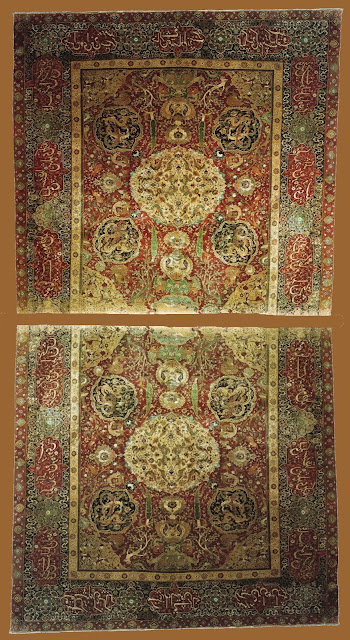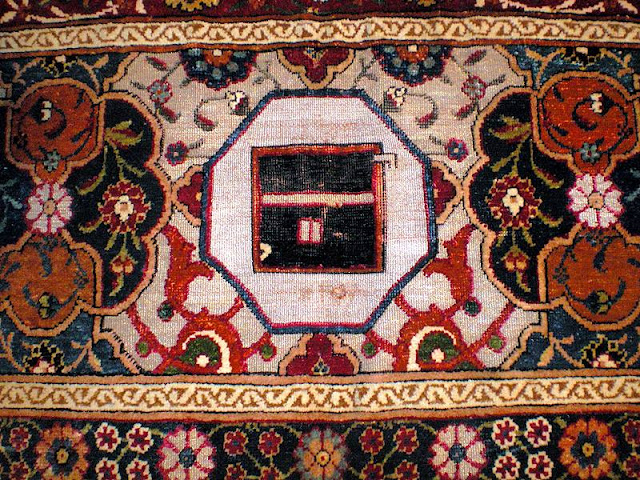 |
| Palazzo Madama |
No pieces for plebs were shown at Turin's Palazzo Madama between September and October 1948,but a high-ranking assortment of carpet nobility, drawn from Italy's finest sources. Curated by Vittorio Viale(with a separate section for tapestries managed by Mercedes Viale)the show opened in newly renovated quarters.Viale seems to have been an all-round talent able to turn his hand to any category of art.In his review of this important show, apparently the first of its kind in Italy, Kurt Erdmann praised the high level of scholarship apparent in the catalogue.
But in post-war Europe,
everything was delayed. The Turin exhibition was held in 1948,yet the
catalogue appeared in 1952. The exhibition in Hamburg, an inventory of
German rug-survivors, was held in 1950 yet Erdmann`s review of the Turin
show appeared in 1957! In 1950 Erdmann knew nothing of the Turin show,
yet in 1952 Viale certainly knew of the Hamburg exhibition, referring to
it a number of times.
 |
| Vittorio Viale |
 |
| 1 |
 |
| 1a |
 |
| 1b |
 |
| 1c |
1)Viale dives into the fray with the Poldi Pezzoli Hunting carpet, a gigantic piece of airport art whose main components are chiefly derivative. The cranes have flown south from the Getty Coronation carpet, whose border angularity has been adopted and exaggerated for the entire field trellis. True artists were at work on the hunting scenes with flashing eyes and white cotton teeth. A border most resembling, but superior to, the Parish-Watson carpet completes the ensemble. No expense has been spared-apart from the addition of “falsies” to the warp ends,silk thread sewn into the carpet to disguise a standard cotton structure ( a technique commonly found on Polonaise carpets) But the carpet is big, it has cliché persian hunting scenes, and has been associated with the nobility-enough to vamp up its status. It desperately wants to be heroic yet with its awkward drawing and overly-dashing huntsmen it misses the mark. A classic nouveau riche carpet, at the 1931 London exhibition it was all the rage.
 |
| 2-Bardini |
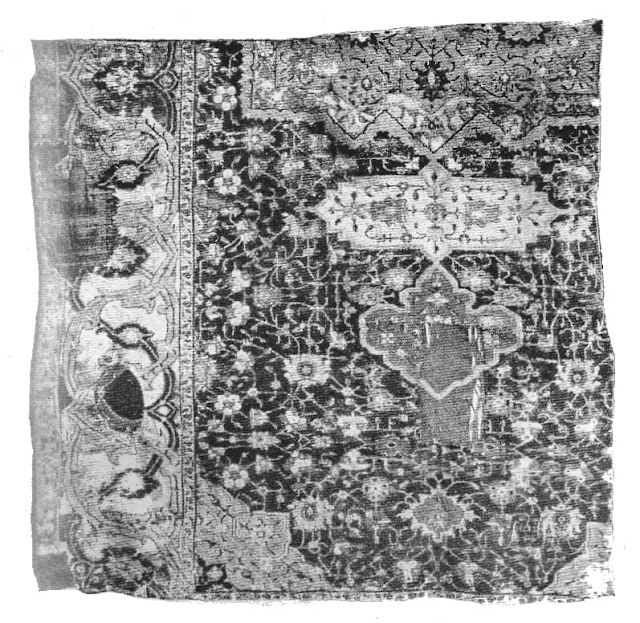 |
| 2a-Ungar Andre |
 |
| 2b |
2) A fragment from the Bardini Museum reunited with another part of the same from the Ungar André Collection. Frequently compared to a large medallion carpet burnt in Berlin in 1945 (2b), this is in sharp contrast to the preceding item: raw power vs. prim decorum. Few carpets of this type have survived.
 |
| 3 |
3) The Poldi Pezzoli Animal-Medallion carpet was purchased in 1855. Together with the V&A `s Garland carpet fragment, a fragment in the Bargello(see next plate) and the von Pannwitz-Thyssen it forms a spearhead of pieces better described as the “ Proto-Salting” group, as they likely precede the main amalgam of such carpets. More elaborate in style, they constitute a bridge between the great classical carpets and the “jazz” style of the Saltings.
 |
| 4 |
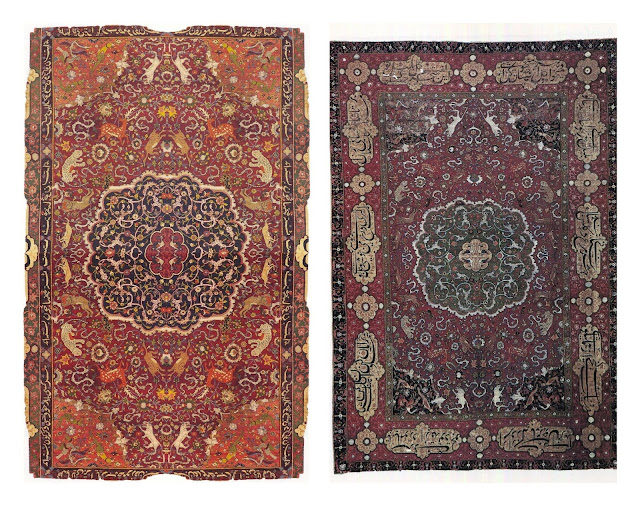 |
| 4a |
4) The Bargello fragment seen here in a reconstruction, with a similar carpet now in Tehran.
 |
| 5 |
 |
| 5a |
 |
| 5c |
5) Vittorio Viale seems really to have understood the group of early Salting carpets, packing them all in together. The Bardini fragment is shown here in a mock-up restoration, alongside the Chelsea carpet, with which it's often compared. The mother of all Saltings?
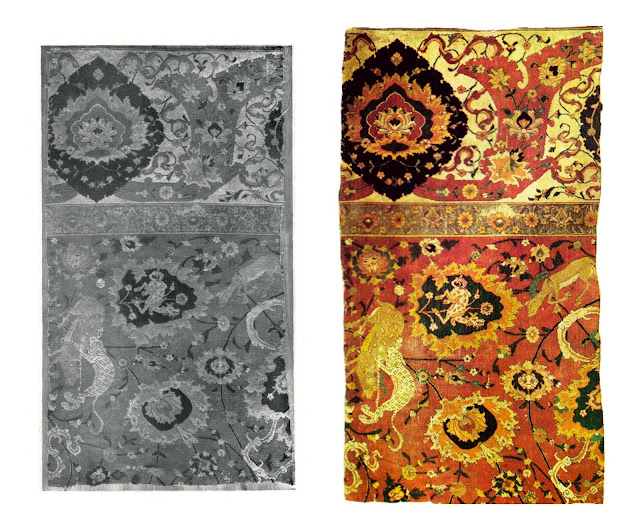 | ||
| 6 |
 |
| 6a |
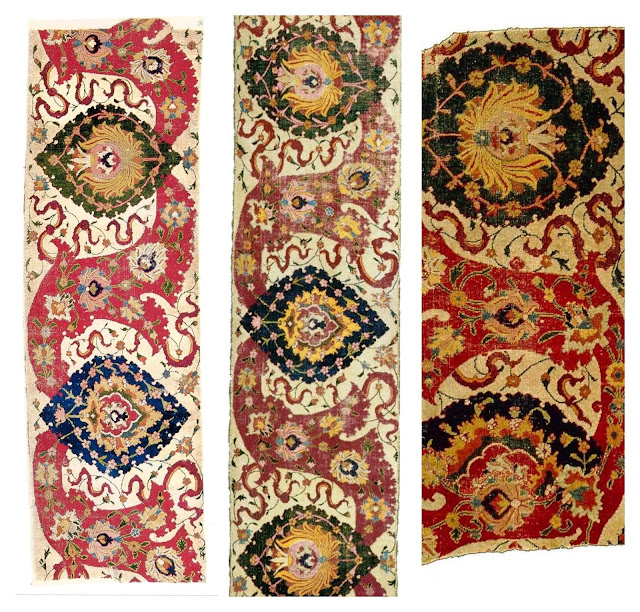 |
| 6b |
6) From Turin`s Museo Civica(where Viale was still director) this fragment is from a group of immaculate rugs derived from the “Emperor” carpets in Vienna and New York.
 |
| 7 |
 |
| 7a |
7) With strange, large palmettes at the center, and lacking the classic cloudband tiara, the Poldi Pezzoli RGF carpet first appeared in 1882.
 |
| 8 |
8)) A silk-warped RGF in the classic style from the Bardini Collection. 212 x 504 cms.
 |
| 9 |
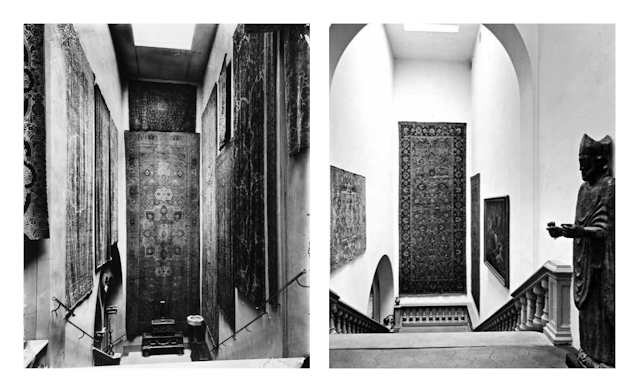 |
| 9a |
9)Writing in his catalogue to the Bardini Museum catalogue(Geometrie d`Oriente,1999),Alberto Boralevi describes this very large RGF carpet as the best preserved piece in the museum. Now mounted on the front wall of the main stairwell at the Bardini Museum,the soaring verticality of the room reminds one of the space created by the late Jim Dixon. There is an apocryphal story that the carpet was used for the reception of Adolf Hitler when he visited Florence in 1938, and that the large vertical cut in the carpet was caused by his spurs. To this day it is known as “Hitler`s Carpet” although the tale is unlikely to be true:the Führer never wore spurs. 280 x 750 cms.
 |
| 10a |
10a) From the Pogliaghi Collection,a large Herat fragment of the type with emergent sickle-leaves. These later became all over leaf patterns,which were also copied in India.The Pogliaghi Collection contributed six pieces to the show;the collection itself, in Varese, needs to be catalogued. 305 x 145 cms.
11) A well drawn Herat carpet, unfortunately lost to view, from the stock of the dealer Accorsi. In lieu of a colour photo, here a good quality fragment from Boston's Museum of Fine Arts. 225 x 135 cms.
 |
| 12 |
12) Another standard RGF carpet from the Lutomirski Collection, also not traceable. 205 x 130 cms.
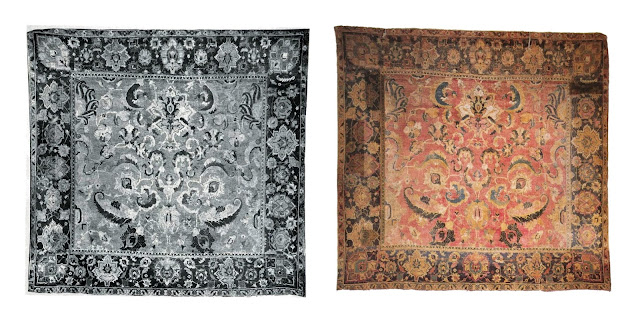 |
| 13 |
 |
| 13a-Marquand Sale |
13) A Herat fragment from a very large carpet indeed. Other pieces of the same rug are illustrated by Boralevi. A more refined carpet, once with Marquand, was sold at Sotheby's in 1976. 277 x 265 cms.
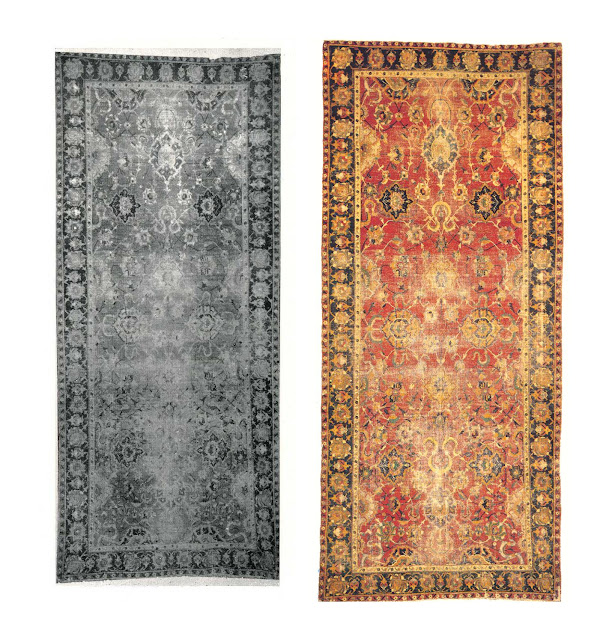 |
| 14 |
 |
| 14a |
14) The Poldi‘s RGF carpet was purchased in 1883 for 440 Lira. It compares quite favourably to a carpet once with Eskenazi, which was once in the Imperial Hapsburg Collection in Vienna, and sold in the interim at the 1960 Myron C. Taylor sale. 178 x 396 cms.
 |
| 15 |
 |
| 15a |
 |
| 15b |
15) A Polonaise carpet from the Argenti Museum in Florence, comparable to two fragments in the Residenz, Munich,and a carpet with the Duke of Buccleuch. Said to be ex-Medici.
 |
| 16 |
16) A second Polonaise carpet from the Argent Museum, Pitti Palace, Florence. Unlike Nr. 15 it utilizes metal-thread brocading. Although Nr.15 appears larger, they are in fact virtually the same “standard” Polonaise size, i.e c.200 x 140 cms. Exhibited in London 1931, Nr.342. More wear than Nr.15.
 |
| 17 |
17) The Pamphily Polonise carpet, still quartered in Rome, has a twin which was recently auctioned at Christie's (1 April 2021)It is shown here (right) for comparison. The carpet was previously published by Battilossi, and brought $2,852,270. The grey ground colour is metal thread brocading.
 |
| 18 |
18) This is one of eight known Polonaise carpets of quality in Venice, from the Museum Correr.Its acquisition date is unknown. It appears heavily brocaded, with a typical Fork-Leaf Arabesque design.
 |
| 19 |
 |
| 19b-Munich-Istanbul |
 |
| 19c |
19) A third silk and metal carpet in the Argenti Museum has been variously attributed to 19th century Turkey and 17th century Iran. The author inclines towards a Turkish origin, as the carpet is much too close in feeling to a number of published prayer carpets,specifically those in Munich and Istanbul. Depictions of the Kaaba seem not to occur in Persian carpets of the classic era. The thick cloud-banding of the Argenti piece seems stiff and awkward, especially when compared to a rug in San Marco, whose relaxed insouciant air shows how such things should be done. Rugs of this type were likely to have misled Kurt Erdmann in the Salting affair.
 |
| 20 |
20) An 18th century Caucasian carpet from the Barbieri stock, falsely described in Viale's text as a stylised Dragon rug. The carpet is a descendent of the great “Sunburst” carpets of the late 17th century, which contain all the seeds necessary for the growth of 19th century Caucasian rug culture:the Chelaberd and especially the Lenkoran carpets whose extrapolated design is based here on addorsed animal motifs matched with a lotus palmette. The Avigdor carpet in Boston, and another large carpet in the Burrell Collection further illustrate this trajectory.
 | |
| 21 |
 |
| 21a |
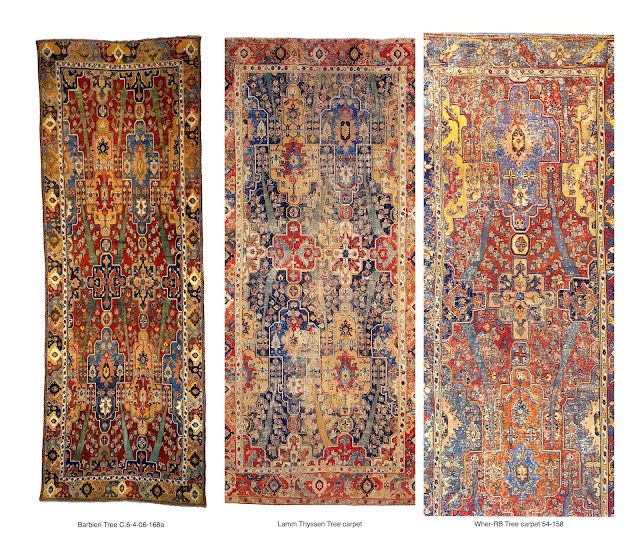 |
| 21b |
21) From a remarkable group of Khorasan carpets with designs of Tree and Cartouche, this effulgent piece from the Bardini Museum has often been reproduced. It has a rare border, even within its group, and a typical example of Bardini “restoration” Three other spectacular carpets of this type are shown for comparison, and a small fragment of a palmette and sickle-leaf design which sold at Rippon-Boswell in 2007 for $9,765.
 |
| 22 |
 |
| 22a |
22)No attempt has been made to connect the various design elements of palmettes,vine and sickle-leaves and medallions. An appealing stiffness wafts across the monitor of this rug, encompassed by a border seen in Indian and Caucasian rugs.This is presumably Khorasan work,no doubt with jufti-knotting; Viale's analysis returns a Senneh knot. Carpets from the Kestner Museum and from the Dixon Collection are shown for comparison.
 |
| 23 |
 |
| 23a |
 |
| 23b-Philadelphia |
23) Described by Viale as Turkish knotted, this Bardini fragment comprising 50 % of the original is actually Persian-knotted and has a cotton warp(information Boralevi, page 123)Thus it may be a prototype from Khorasan. Avshan designs are scarce in N.E Iran, where the Harshang was preferred. The ground tracery is more refined and floral than in the Caucasian versions, of which an example in Philadelphia gives a good idea. Two further examples can be added to the rare red-ground group.
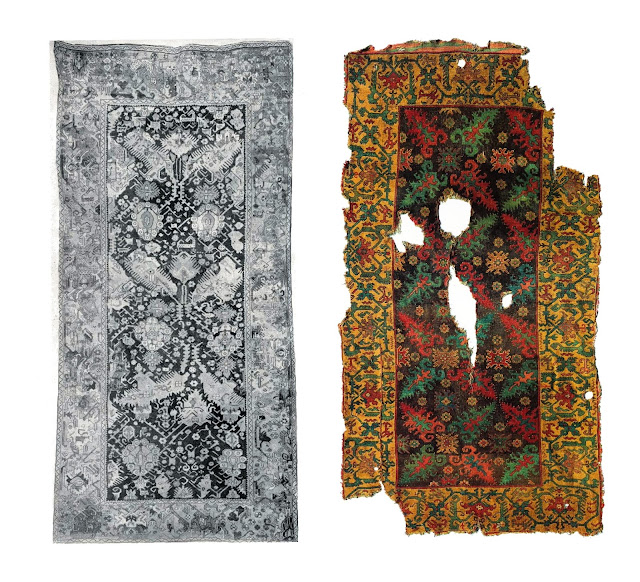 |
| 24 |
24) Surely not Caucasian but perhaps from the NW Persian frontier, this carpet appears to imitate a piece in the Vakflar Museum Istanbul. The Turkish rug, with an animal-floral design of cypress trees transforming into scorpions and Mother Goddesses, is clearly very old, and possibly unique. From the mysterious Engineer Piero Barbieri.
 |
| 25 |
25) A magical Mamluk fragment of many colours, yet another smash hit from the Antiquarian Bardini. Presumably a three medallion carpet; of interest are the repeating rosettes at the mid-point of the border.
 |
| 26 |
 |
| 26a |
26)With its unusual rectangular format, the Pogliaghi Mamluke is a rare item demonstrating that the Egyptian weavers could work to order.
27)A fragmentary Mamluk carpet from the collection of Franco Rolich, Triest. The only example not illustrated in the catalogue. 224 x 194 cms.
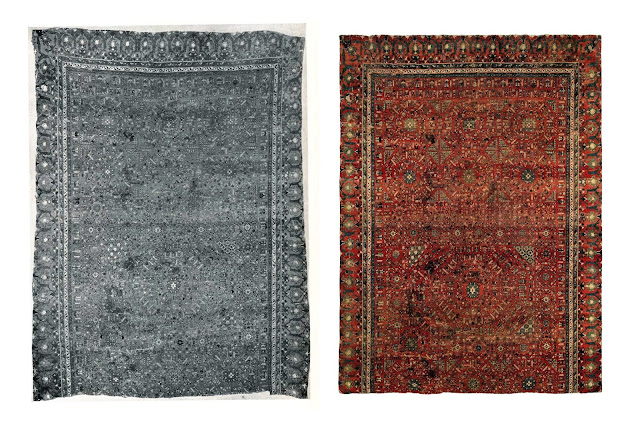 |
| 28 |
 |
| 28a |
28) This large fragment of a Para-Mamluk carpet with 6-1 design has a border seen on some Chessboard carpets. In 1948 with Campana, it was last seen at the Palazzo Ducale exhibition in Urbino.
 |
| 29 |
 |
| 29a |
29) Cairene weavers were already skilled at creating shaped carpets; at least three round Mamluk carpets are known. The table for which this shaped Cairene carpet was made must have been of great import. Adorned with a classic Cairene design of medallion and Saz leaves, it forms the Sign of the Cross and has a counterpart now in the Victoria & Albert Museum London.Two other fragments of such table carpets are known.Civic Museum,San Gimignano. 350 x 212 cms.
 |
| 30 |
 |
| 30a |
 |
| 30b |
30) No colour plate of this Cairene carpet fragment exists, which, with its five colours and radial design of Tulip sprigs and concealed medallions, must have been extremley interesting. Such Tulip sprigs are almost never seen as a field element, appearing infrequently as on a fragment at the AAA in 1924, in a table fragment with the Franchetti Collection, and adorning the corners of the aforementioned table carpet in the V&A.
 |
| 31 |
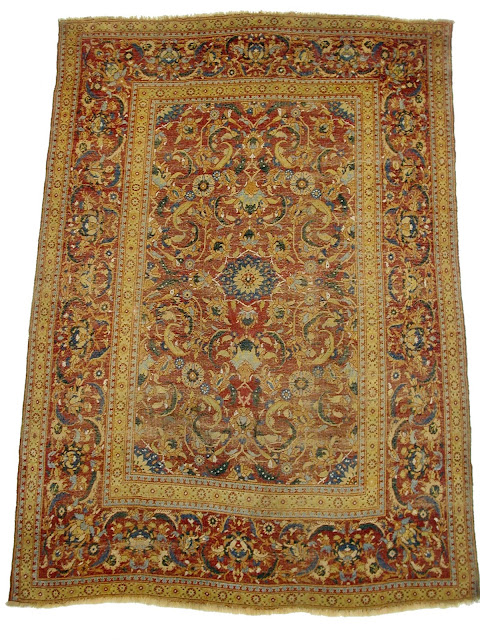 |
| 31a |
A similar carpet is the Ballard example,now MET 22.100.53.
How refreshing such carpets are,compared to the authoritarian Mamlukes, or indeed the cumbersome Ushaks.What genius dreamt them up?
 |
| 32 |
32)The only known Chessboard rug with a 4-and-1 design,indicating its Anatolian influence.A further design reduction can be seen in a carpet from the Ballard Collection in St.Louis.From the versatile Sig. Barbieri.
 |
| 33 |
33)There are two basic types of Chessboard carpets.In the first group the area between the main Göl design forms a separate,connected space-a figure-ground dynamic.In the second group the designs are free-floating.The Bardini carpet belongs to Group A,and is the only large one with a medallion border.
 |
| 34 |
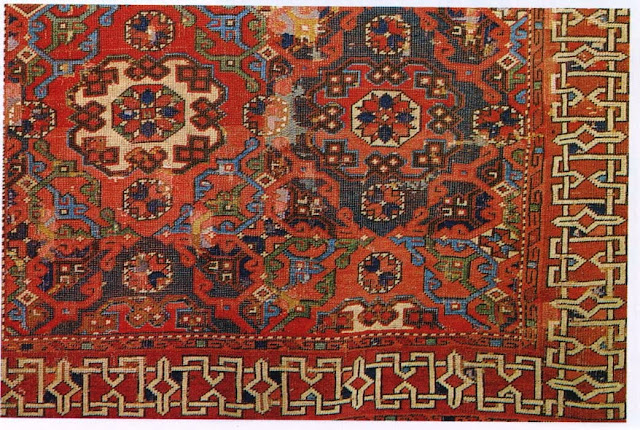 |
| 34a |
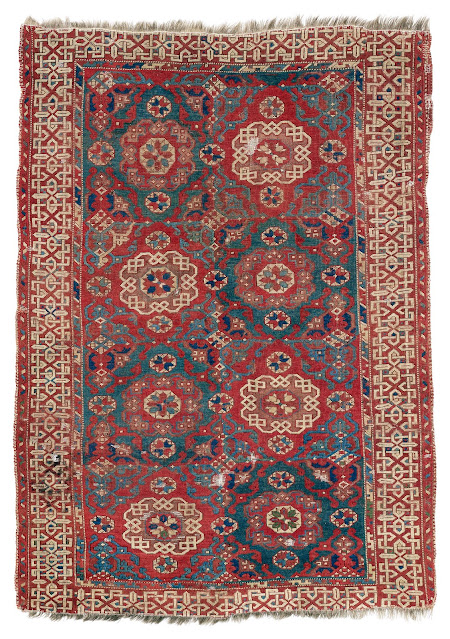 |
| 34b |
34) A two-tone SPH rug with two rows and a rare spacious border.Such rugs rarely surface on the open market,but a piece at Rippon Boswell smashed all records in 2019,achieving $248,400.
 |
| 35 |
 |
| 35a |
 |
| 35b |
35) A total of seven Lotto carpets at the Turin show reveals Italy`s profound love-affair with oriental rug, either as importer in the 16th-17th centuries, or exporter in the 19th. Nr 35 in the catalogue from the Pogliaghi Collection seems not to have been published elsewhere.As Viale points out, the nearest comparison is a rug in the V&A. Both pieces are in the Anatolian style with a closed “x-box” Kufi border. Such borders have sometimes been said to represent a later style, and the half-open style has been seen as earlier. However,a carpet sold at Koller in 2019 employs both types-the half-open at the base of the rug and the x-box at the sides. The carpet has been severly reconfigured, but it`s likely that the half-open border finished off at the top.
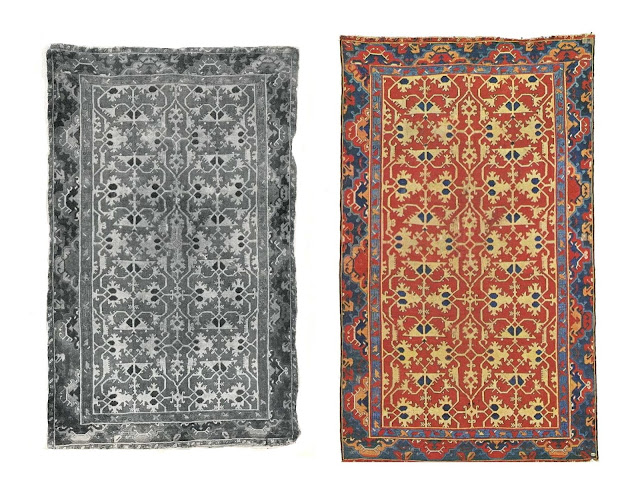 |
| 36 |
 |
| 36a left: Christies 2017-right: Zaleski Collection |
36) An eloquent Anatolian style Lotto with half-medallion border from Bardini.Some eleven examples in this exact style have been recorded, and they do appear sometimes at auction: Finarte 1992 sold for $48,760; Christies 2001,sold for $133,040; Christies 2017, sold for $261,110.
 |
| 37 |
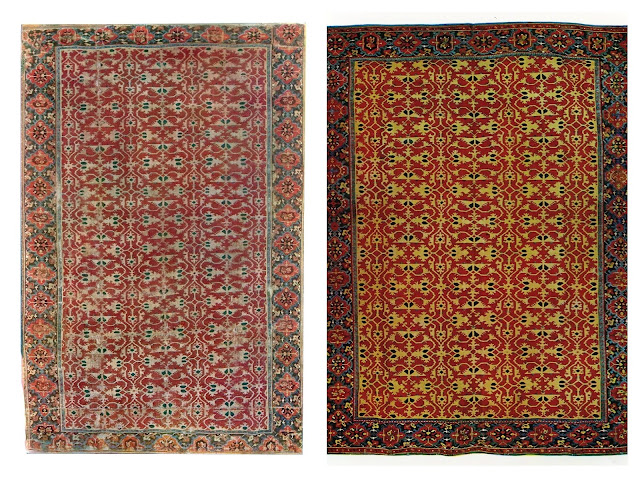 |
| 37a |
37) Barbieri`s large Lotto seems to have disappeared. With its size, Anatolian style, and medallion border it resembles two rugs published by Italian dealers (37a-left: Campana, right: Cohen)Large rugs of this type seem later; perhaps importers in Italy initially tested the market with smaller examples. 500 x 240 cms.
 |
| 38 |
 |
| 38a |
38) Another large Lotto from the Bargello Museum in Florence.A closeup shows the numinous quality of dye achieved by Anatolian craftsmen at that time,which went on to influence Italian-and by default-European painting. 515 x 260 cms.
 |
| 39 |
 |
| 40 |
39 & 40) Barbieri`s Lotto has vanished, but plate 40 is a rug in the same ornamental style, and with similar borders. The Barbieri has a narrow inner guard lacking in the Pogliaghi piece.
 |
| 41 |
41)A classic kilim style Lotto with cloudband borders has only been published once to the author`s knowledge. From the Pogliaghi Collection, which should be collated and published now, before the mice have their way.
 |
| 42 |
 |
| 42a |
42) In the grand tradition of Anatolian medallion carpets this piece from the Poldi Pezzoli provoked diverging views in the German carpet world. Bode considered it a masterpiece(which it is) whereas Erdmann was dismissive of its squashed medallion. It can be compared to a larger, but lesser item in the Orient Stars Collection, and more closely to a fragment in Konya. The interesting border with hidden swastika displays a “Key” motif also used occasionally in Lotto carpets and as an all-over pattern in a carpet donated by Bode to the Berlin Museum.
 |
| 43 |
 |
| 43a |
43) Most of the carpets in the Turin Exhibition of which no contemporary photos survive were once with Barbieri;why they are missing and where they have gone is a mystery.His blueground LMU is represented here by three supreme examples.
 |
| 44 |
44) A rare LMU from Barbieri with a leaf-filled central medallion is shown here with the best of type from Moshe Tabibnia.
 |
| 45 |
 |
| 45a |
45) Another rare group of Medallion Ushaks is represented here by an item from the Lutomirski Collection, which Viale thought was a fragment,although Erdmann disagreed. It is hard to imagine the piece as complete, when all the other pieces in this cluster are large carpets or fragments.
 |
| 46 |
46) A small LMU from Cittone which re-surfaced at Christies in 2016 went unsold. 280 x 205 cms.
 |
| 47 |
47) With it's rare,village style border, this Star Ushak resembles a carpet at the Bode estate sale. Barbieri,now missing.
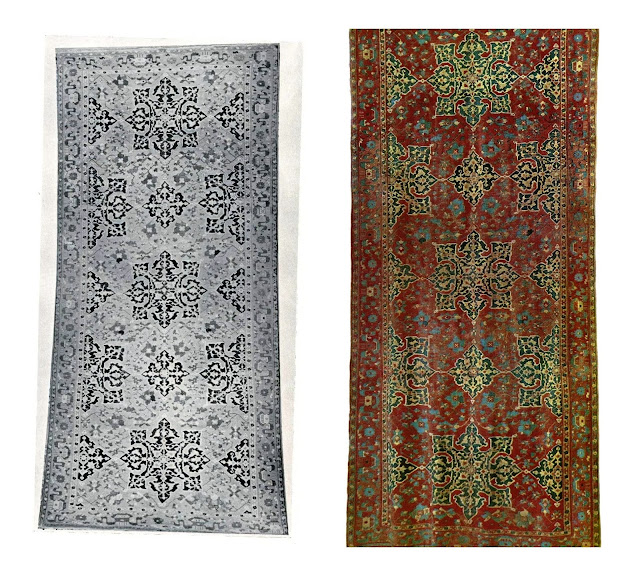 |
| 48 |
48) The Bargello Museum’s impressive Star Ushak with cloudband border.
 |
| 49 |
 |
| 49a |
49) Rare and wonderful,the Pogliaghi Bellini Ushak, its face scarred by diagonal lazy lines, represents a colossal reduction when seen against the Berlin example.
 |
| 50 |
50) At last a resurfaced rug from Barbieri, this eloquent SMU from the smaller group with “Book-Cover” mihrab was published by Alberto Boralevi in 1987 with its field repairs painted over, and was later seen with Peter Bausback in 2008. In 2019,with its repairs once again visible, it was auctioned at Sothebys for $27,760.
 |
| 51 |
 |
| 51a |
51) A rare type of SMU carpet with Animal-Pelt mihrab and dotted spandrels from the Bardini Museum. Few of this exact type have survived, but offered for comparison here are a carpet in Philadelphia, and one published by Neugebauer-Orendi.
 |
| 52 |
 |
| 52a |
52) There are two types of floral encircled medallions in the Transylvanian group. One has a simple string of rosettes around the medallion, the other has an extra ornament between the flowers. The latter is used invariably on carpets with a double-hook border; the simpler version, as here, appears on those carpets with a simple cartouche border where the hooks point in one direction. This carpet, from the Lutomirski Collection, was sold at the Cassirer-Helbing auction in 1925 and published by Bode-Kühnel in 1955.It has since disappeared.An item from the Toms Collection sale in 1995,which sold for $20,115,is shown here for comparison.
 |
| 53 |
 |
| 53a-Halevim |
53) Christened “Davanzati” by the author, such carpets are invariably on a red ground. But this piece and another from David Halevim have yellow, or yellow-tan grounds. The Bardini rug suffers from having lost its upper and lower borders, producing a squat look.
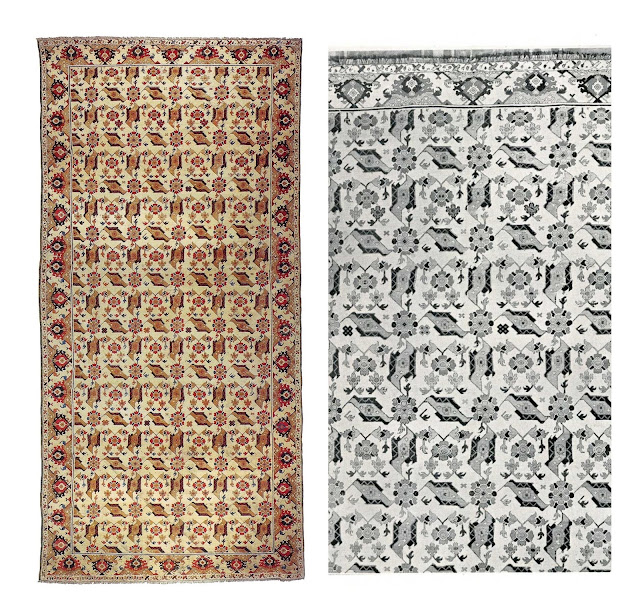 |
| 54 |
 |
| 54a |
54) The author has always found the Selendi rugs with Kis-Ghiordes border to be the most beautiful. There are at least another two 5-width Bird examples known, apart from this piece in the Bargello Museum: a carpet in the Crocker Collection published by Aga-Oglu, and a piece discovered by the indefatigable Alberto Boralevi in Assisi( colour repro)
 |
| 55 |
 |
| 55a |
55) Kurt Erdmann described the drawing of this piece from the Accorsi stock as “rather hard” It is presumably a fake. Three years later he was to purchase another fake Selendi rug with Chintamani design (actually a rather beautiful carpet)
 |
| 56a |
56a) No fake this one, but a severely beautiful example from the Bardini Museum, a tribute to the old Antiquarian`s fantastic eye. It may well have served as a model for the Berlin Museum ’s copy. Was Tuduc ever in Florence?
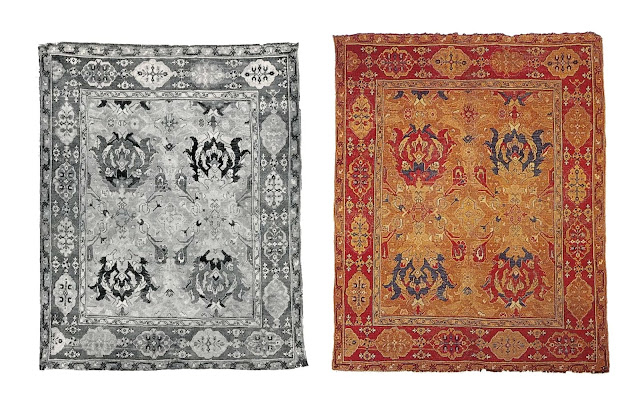 |
| 57 |
 |
| 57a |
 |
| 58 |
 |
| 58a |
58) A second Smyrna from Campana has a rare border seen also on a rug in Budapest and another in the Ballard Collection. A related border was also used on Ambassador Aita`s carpet sold at Christies in 2001 for $ 63,040.
 |
| 59-left, Accorsi Gallery-right, Museum of Islamic Art, Berlin |
 |
| 59a |
59) A true knotted icon is the “Synagogue” carpet in Berlin, purchased by Bode in Munich, 1884, and said to have come from a church in Tyrol. It was first published in 1892. This spiritless but rare copy was declared as Anatolian work in the catalogue, with Turkish knot. The Accorsi Gallery was surely an interesting minefield for the collector.
 |
| 60 |
 |
| 60a |
60) A magnificent note to end on, and Viale`s only non-classical concession, this Khotan carpet with the Yarkand ramshorn border was lately with Moshe Tabibnia. It generates a beatific atmosphere without any obtrusive ornament. It is the Khotan version closest to the supreme Yarkand group, amongst which are some of the most beautiful carpets ever woven.

